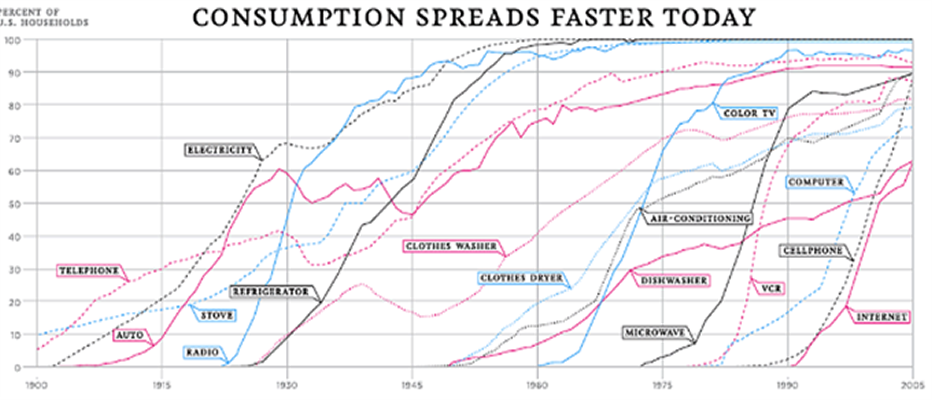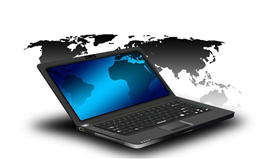Social Change
Technology and Change
MINDS ON
“
Ethics change with technology.
~ Larry Niven
ACTION
Historical Changes in Technology

Stop for a moment to consider the changes in technology that you have experienced during your lifetime. Many of the items that we consider to be necessities – including cell phones, Internet access, and home computers - were not in common usage even 25 or 50 years ago. Social media is quite new as well, with Facebook breaking new ground after it was founded in 2004.
Reflect on the graph below and consider the access that you personally have to each of these technologies. What needs to be added after the graph ends in 2005?

The Internet began to resemble its current form in the early 1990s. However, the initial components of the Internet came about as early as 1969 - as is explained in this timeline.
When you think back to your childhood, what was the technology situation in your elementary school? Currently, the majority of Ontario schools have classroom computers with interactive projectors, mobile technology using multiple platforms, and perhaps, robotics clubs and audio or visual creation studios. Students often harness the educational power of their personal devices through Bring Your Own Device (BYOD) initiatives, and Wi-Fi is ubiquitous in most buildings. We have come to a period when Internet access is available almost all the time, in almost all locations - if one has a capable device. Consider the statistics about Internet users. While this information can be considered direct data (i.e. the information displayed in the data), it can also be considered indirect data (i.e. how access to technology is changing by region).
 Technological Change
Technological Change
What technological change that has affected your life do you remember most vividly? Think about the following:
- the technology;
- the year;
- your memory of the new technology; and
- why this has caused change in your life.
You should also consider the following:
- In your opinion, are there any negative repercussions to the invention or adoption of this particular technology?
- In Unit 2, Activity 1 you were introduced to a number of social science theories. Utilizing this information repeated below, view the addition of this technology through one of those lenses.
SocialChangeTheories
Technology and Communication
To what degree is technology infused in your life? How long can you be without a cell phone? The Internet? The image below indicates the real time usage of a number of online applications. Take a moment to compare your usage to that of the general population. How many of the platforms shown do you use? Are there any platforms that you have never heard of before?
While it is undeniable that access to technology has changed the way we live, some people would argue that this change has not always been for the better. One of the most commonly heard concerns is that people no longer communicate in traditional ways. The video below describes some of the impacts of technology on communication. Consider the following:
- Do you communicate in a ‘real' way when utilizing technology?
- Do you have close relationships with more people or fewer people than you might without technology?
- How many times a day do you check in with social media?
- Do you believe that your online identity is a true reflection of your actual identity?
- Do you share any of the concerns detailed in the video, or do you ascribe more to the positive results mentioned?
The quotation at the top of this lesson stated, “Ethics change with technology.” It seems difficult to argue that the way we communicate has not been affected by technology – specifically cell phones and social media - over the last 20 years. What are the ethical implications involved with new technologies? Have these ethical implications changed in that same period of time?
The video below presents many common practices on the Internet. You may be aware of some, and others might surprise you. The question is – do you consider these to be of ethical concern?
The question at the top of this lesson asks ‘Are there any areas in which you believe changes as a result of technology have been more of a detriment than an advantage?” After watching the above video, did your response change in any way?
What if you knew that financial institutions could utilize Facebook to determine whether you receive a loan based on the people who are your friends? Would that cross an ethical line?
How Technology Creates Change
We know that technology changes our daily lives, and in fact, technological innovations are occurring at an astonishing rate. We can search any fact we need to know instantly on the Internet; this makes memorized knowledge obsolete. We can communicate at all times with others. We can use technology to navigate between two locations and to entertain ourselves.
The question now moves from how technology can change our personal lives in larger ways, to how it can change lives globally.
The videos below highlight some examples of how people have embarked on projects of change with technology.
Teen Inventor – Charging Mugs and Flashlights
While charging your cell phone in unconventional ways may be convenient, what are the extension applications for this technology which may be even more useful worldwide? Think about people who don't have access to electricity on a regular basis. What else may be adapted to run from a USB connection?
Billions in Change (access the full-length version)
It is important to acknowledge that technology has different impacts in different geographic areas in North America, as well as in different parts of the world. In fact, depending upon geographic location and economic class, getting a new cell phone, for example, will have a different impact on people. For some, it may be an exciting event, but it wouldn't change their lifestyles. For other individuals, getting a new cell phone might have huge implications such as access to information, communication, and even safety. This difference in access to technology is termed the digital divide.(definition:the gap between physical regions on Earth or demographic groups in their access to technology and information. This may include computers, the Internet, television, and telephones.) Leaving the example of the cell phone, let's imagine that a new technology was a medical device proven to save lives. Should only those who can afford to pay be given access? Now we return to the quotation opening this activity – sometimes technology does change ethics. Suddenly, this situation becomes a very grey area with corporate profit on one side and access to technology on the other. In fact, many social causes focus on allowing equal access to advancements that change lives.
Using Technology to Create Social Change
As you know, the culminating task in this course is concerned with social change. Your task is to identify an area of need and to create change. Overwhelmingly, campaigns of change today involve some aspect of technology (although it is possible to create an action plan that is not technologically dependent). Perhaps the largest change is that technology gives the ‘average person' a voice. No longer do you need to be a political or news personality to share a message. Anyone with a blog, social media account, or simply Internet access can become active in leading or supporting social change. We have seen recent examples of this across the globe with Syrian refugees using social media apps and GPS to help each other as they make their way to new countries while remaining in touch with their families. Londoners living in Brixton are using technology to bring awareness to the gentrification that is taking over their neighborhood.
Another aspect of social change that has been affected by technology is the idea of globalization(definition:the interaction of people, groups, companies or governments in different countries around the world.) Only a few decades ago, activism was seen only in a small geographic area which surrounded the issue. Now, because of the instantaneous ease of sharing information worldwide, people are not only more aware of issues in distant places, but are also able to contribute to any cause – near or far - through monetary donations, by signing a petition, or helping to grow its message.

The following campaigns are examples of how technology has been utilized to create change.
Campaigns
The difficulty with technology is that it is constantly changing, but this is its advantage as well. With each new application comes another opportunity to utilize technology in a way that benefits people and potentially helps to bridge the digital divide.
CONSOLIDATION
 Groundbreaking Technology
Groundbreaking Technology
Technology is constantly changing.
You will create a presentation on groundbreaking technology using any software application of your choice that has the capability to record an audio track. This might be software that you have access to or any free online application. The images and (minimal) words that you use in your presentation will be explained by the narration that you write and record within your presentation.
The topic for the presentation will be an emerging technology of your choice. Keep in mind that it needs to be brand new – if you have seen it in stores, or more than one person out of five has heard about it, it is old news. We're looking for brand new learning here!
When you have selected your technology, create a presentation which shares the following:
- Information about the technology:
- what it does (the intended purpose, but unintended purposes, as well);
- how it does it; and
- who invented it, when, how, and why.
- The implications of this technology:
- What will it change? Can the changed be linked to at least two social institutions (education, religion, media, family, employment, health care)?
- Will everyone have access? (Consider the digital divide) Should everyone have access?
- How is this technology connected to one of the factors of change from Unit 2, Activity 2?
Consider using more images than text in your presentation since you will use narration to explain the information and implications of the technology you choose. Also, consider adding a short video clip if it adds to your topic.
If you need some tips on what makes a good presentation, visit this Microsoft Resource.
In a later activity, you will be asked to analyse how technology was utilized in a campaign for social change. You will also consider how technology may be involved in your action plan to help you ensure success. Keep this in mind as you move through future activities.